The answer to Bloom Day, the 15th of every month, is the Foliage Follow-up, the brainchild of Pam Pennick of the excellent blog Digging, whose garden has endured both record high temps in summer and now record low temps this winter — kinda why “climate change” is more apt a term than “global warming,” since every cold spell is pounced upon as proof, aha! that carbon dioxide emissions are not causing warming (because then we’d be warm and sweaty all the time, right?) and that it’s all the socialist payback plot of evil scientists. But as reader Paul Schickler of Brooklyn so ably stated in a letter to the New York Times on January 1, 2010, “Yes, we may possibly err in thinking that we need to spend uncounted billions on green technologies, new industries and fostering worldwide unanimity of purpose. But if climate fears do turn out to be less than apocalyptic, we can ease our embarrassment with a full-employment economy, fiscal surplus, clean air, a more peaceful world and a more optimistic future for our children. I’m ready to be thus embarrassed.”
Whoops, where’d that digression come from? Back to the garden…
This whole enterprise of naming what’s in bloom and leaf seems so unfair on my part because here in zone 10 we usually don’t get temps lower than the 40s to contend with — this winter at least, so far, knock wood — so consequently there’s always lots in bloom and leaf, no matter the skill level of the gardener, and if you’ve got garden space for exotic evergreen shrubs, the sky’s the limit. (A couple years ago, a rare freeze did occur, and it was the talk of the town. I lost a sole plectranthus and the cats’ water bowl iced over, nothing to cry over. The Huntington Botanical Garden had just bedded out masses of Zwartkop aeoniums, all of which were lost, amongst other tender stuff. It also, strangely enough, snowed in South Central L.A., but only there.)
But soon enough, probably around June, as I check the Bloom Day blogs (a day shy of that other famous Bloomsday of James Joyce’s Ulysses, June 16, commemorating June 16, 1904), I’ll bewail the deficit of strong perennial bloom in my garden, the sore lack of breezy, Piet Oudolfesque, diaphanous beauties like veronicastrum, astrantia, the zaftig prairie stalwarts like baptisia and eupatorium that refuse to check in at the Hotel Southern California of the endless summers and suburbs, of the 4-Oh-5 and 1-Oh-1 freeways, of the lack of proper winter chill. We’ve all got our zonal (and urban planning) crosses to bear.
So with that disclaimer, and barring further digressions, I offer the leafy charms of Coprosma ‘County Park Red’

Sedum nussbaumerianum, Coppertone Stonecrop:
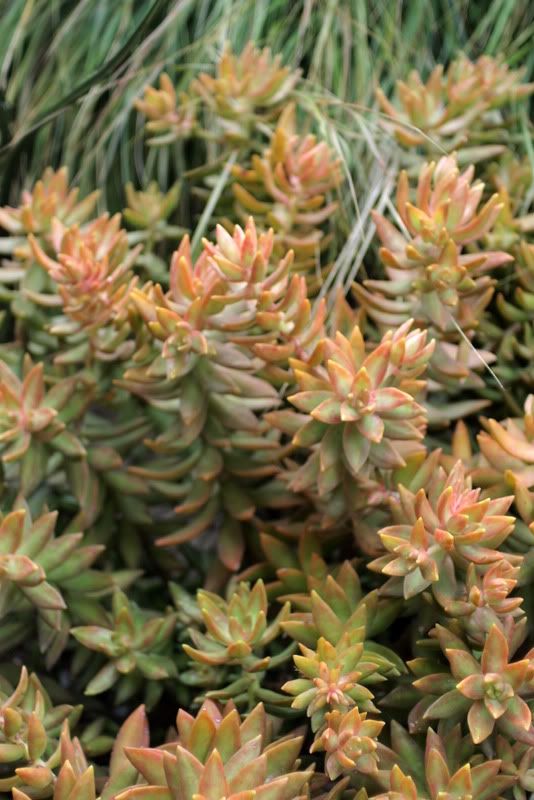
Oxalis spiralis sprawls in the cool winter months then retreats during summer. The dark burgundy form is out of frame, planted in the ground. The variegated plant is a sterile basil ‘Pesto Perpetuo.’ So pretty, I haven’t as yet snagged a leaf for the kitchen. And with tomatoes out of season, what’s the point anyway?
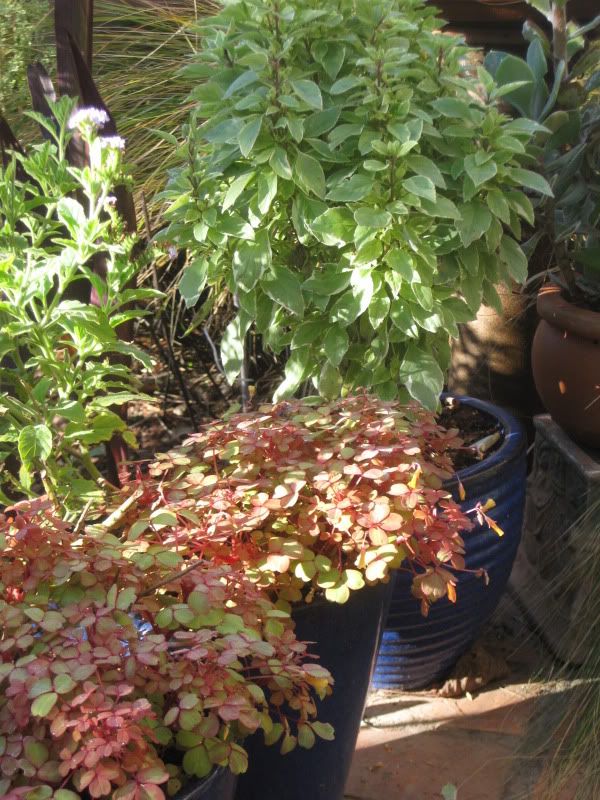
Fatshedera, bigeneric cross of, you guessed it, fatsia and hedera, picked up at the Cistus Nursery of Portland, Oregon, this past July. Lost the tag to this cultivar:
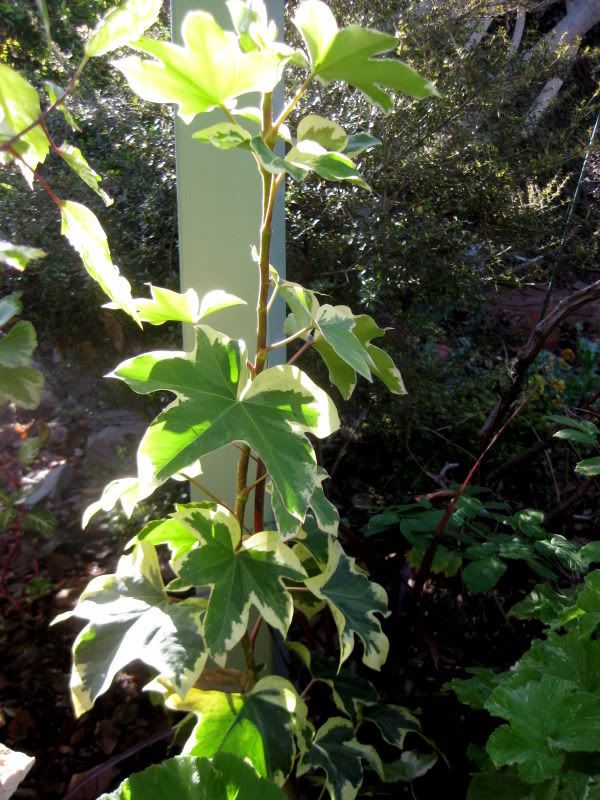
The round-leaved mint bush, Prostanthera. I assumed this is P. rotundifolia but find reference to the variegated mint bush as P. ovalifolia. Whatever it is, it’s a lovely, minty, shimmering shrub from Australia that I’ve grown off and on for over a decade. Tiny lavender bells appear in spring. It can get big fast:

The little Moroccan toadflax likes the cool winter temps too. Linaria reticulata ‘Flamenco’:
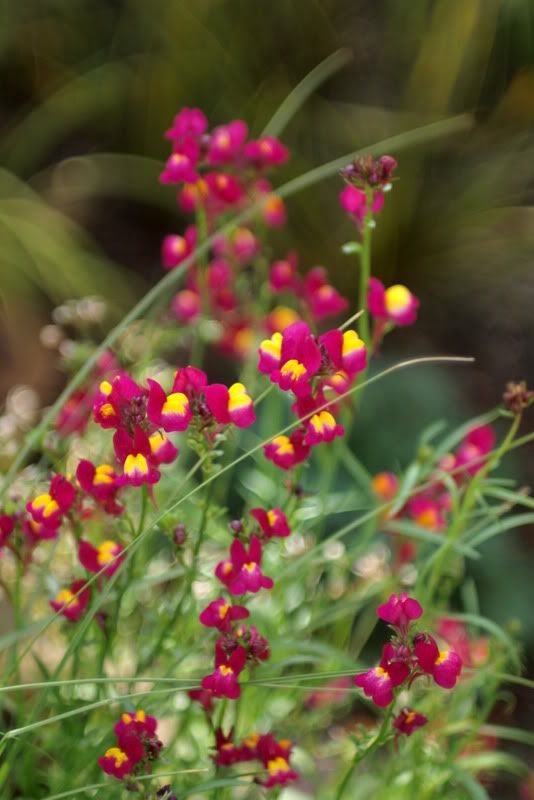
Another fine-leaved shrub, the New Zealander Lophomyrtus x ralphii ‘Red Dragon’ that I keep in pots to bring to the fore when the succulence of summer’s bounty can no longer upstage their delicate beauty. (That and the fact that there’s simply no ground left in which to to plant them.)
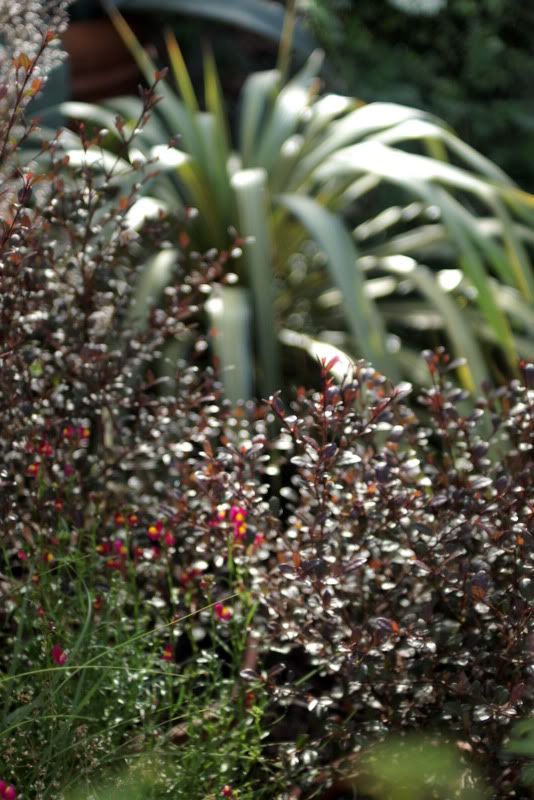
Hebe ‘Quicksilver’ bringing a cross-stitch counterpoint to the solidity of a potted agave:
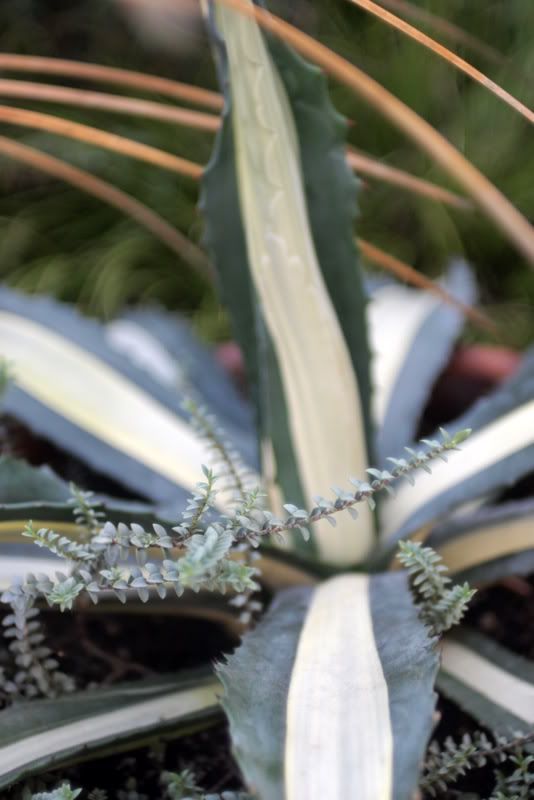
Hellebore argutifolius is in bloom, as are still the Waverly salvias and Teucrium azureum, thank goodness, for the hummers that stop by several times a day. Salvia chiapensis is awakening. The bronzy fennel backs rusty spears of Libertia peregrinans, and the white umbellifer Orlaya grandiflora has started to bloom.
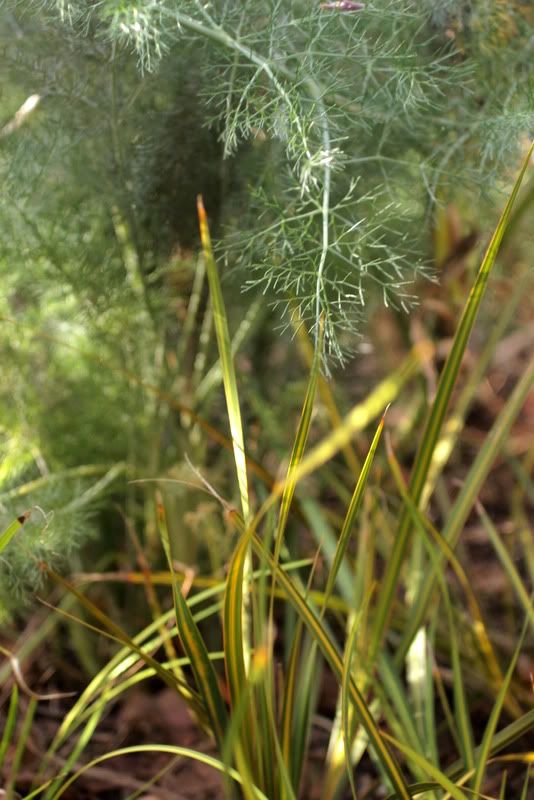
There’s lots to look at in January. Temps are mostly in the 60s, sometimes 70s. The light is wonderful, not the “toaster oven” light of summer, as cinematographer Gordon Willis described Los Angeles light to Terry Gross in a Fresh Air interview. But I digress…

These lovely California gardens can drive a girl insane. You have a drool-worthy collection here. I love that mint bush (could it grow in Austin, could it, could it?), the Coppertone stonecrop, and the Moroccan toadflax (even though that’s technically in flower–ha). You have toaster oven light in summer? We have the death star. Same difference probably.
Thanks for participating in Foliage Follow-Up, Denise. I found your post through a ping on my blog. But if you will leave a comment on my Foliage Follow-Up post and include your link to this post, others will be able to find it as well. Cheers, Pam
Thanks for the nice comments, Pam. The mint bush is supposedly hardy to approx 20 deg, so in a reasonable Austin winter — but the weather just hasn’t been reasonable lately, has it? It’s a quick grower, so I’d say go for it. I’m not sure I’m ready to link up yet, still finding my way with blogging and the camera, but hope to soon.